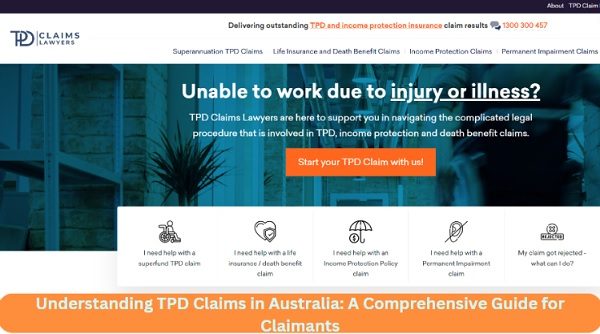
Understanding TPD Claims in Australia: A Comprehensive Guide for Claimants
What is a TPD Claim?
A Total and Permanent Disability (TPD) claim is a legal remedy designed to assist individuals who are unable to work due to serious illness or injury, providing financial assistance for those dealing with permanent impairments.
Understanding TPD Claims in Australia
Now that we’re in Australia, it’s important to understand the laws and policies that apply to TPD claims there. The process is shaped in large part by the legal environment, and being aware of these factors guarantees a more seamless TPD claim process.
The A-Z of TPD Claims: What They Are and How to Apply
We explain the nuances of TPD claims in this portion of the thorough guide, giving you a clear road map from comprehending what TPD claims include to assisting you with the application process.
Eligibility Criteria for TPD Claims
It must fulfill certain qualifying requirements to begin the TPD claim process. Usually, the focus of these requirements is being “totally and permanently disabled.” This section explains what constitutes a debilitating condition and what kind of proof you need to back up your claim.
Step-by-Step Process of Filing a TPD Claim in Queensland
The text provides a detailed procedure for submitting a TPD claim, guiding users through every step from consideration to submission, ensuring they are prepared to handle the application’s intricacies.
- Making the first claim
- Recognize when and how to file a TPD claim.
- The practicality of action is crucial in the claims procedure.
- Requirements for documentation
- A thorough rundown of the paperwork needed to back up your claim.
- Some pointers for efficiently arranging and displaying your documentation.
- Lawful Points to Remember
- Information about the legal ramifications of TPD claims.
- Why legal counsel may be helpful in specific situations.
- Evaluation Procedure
- An examination of the evaluation process for TPD cases.
- Being aware of the standards that assessors use.
- Possible Obstacles and How to Get Past Them
- Common difficulties encountered when filing a TPD claim.
- Helpful guidance on overcoming setbacks and maintaining resilience.
- The Significance of Medical Data
- Comprehensive examination of the vital role that medical evidence plays.
- kinds of medical records that support your allegations.
Navigating the Challenges of TPD Claims: Tips and Advice
It can be difficult to navigate the complex world of total and permanent disability (TPD) claims, and there are frequently many obstacles in the way. This section offers you vital guidance and recommendations to assist you in overcoming these obstacles and raising your chances of a successful TPD claim.
- Understanding Common Challenges
It’s important to understand typical difficulties that claimants frequently encounter before digging into remedies. These could include dealing with insurer resistance, making the required paperwork difficult, or experiencing processing delays. The first step in overcoming these obstacles is acknowledging them.
- Obtaining Expert Advice
To assist you with the procedure, think about hiring experts like attorneys or claims consultants. Their knowledge can be very helpful in deciphering intricate legalese, making sure all conditions are fulfilled, and offering assistance in the event of disagreements.
- Quick Action Is Essential
When it comes to TPD claims, time is crucial. Starting the procedure as soon as possible helps reduce the possibility of delays and improve the likelihood of a more seamless claim process. Act quickly because waiting around could cause issues or possibly result in your claim being denied.
- Arranging Detailed Recordkeeping
It is essential to collect and arrange the required papers. Reports, medical records, and any other supporting documentation for your claim are included in this. Make sure all of your documentation paints a clear picture of the extent and duration of your condition.
- Discreet correspondence with insurers
It’s critical to keep lines of communication open with your insurance provider. Report back to them on your progress and answer any questions they may have for more details right away. Fostering a constructive connection through open and honest communication may speed up the claims process.
Expert Perspectives: How TPD Claims are Assessed
Have you ever wondered what goes on behind closed doors while TPD claims are being evaluated? In this section, knowledgeable attorneys provide their perspectives on the assessment procedure, providing an overview of the elements that may have a substantial influence on the result of your lawsuit.
You will have a thorough grasp of TPD claims by the end of this section, along with a helpful application process guide that will put you on the right track toward receiving financial assistance during difficult times
The Role of Medical Evidence in Your TPD Claim
A vital component of the TPD claims procedure, medical proof has a big impact on how well your claim is handled. Appropriate documentation is crucial because it provides concrete evidence of the extent and duration of your condition. Expert opinions, diagnostic test results, and medical records can all be included in this evidence. Your case will become stronger the more thorough and precise your medical records are. It not only supports your claim but also gives insurance assessors a clear picture, enabling them to determine the actual impact of your condition. Thus, gathering thorough and comprehensive medical documentation is essential to getting a good result for your TPD claim.
The Impact of New Legislation on TPD Claims in Australia
As laws change, so too does the landscape of TPD claims, therefore it’s critical to be informed. The TPD claims procedure may be considerably impacted by recent legislation amendments. Claiming parties can modify their strategy by being aware of these changes. Whether changes impact eligibility requirements or the assessment procedure, maintaining current guarantees that your TPD claim complies with the most recent legal standards. In light of any changes to the law, this knowledge enables claimants to make well-informed judgments, successfully handle the claims process, and raise the possibility of a favorable result.
Common Misconceptions about TPD Claims Debunked
Confusion and a clear comprehension of TPD claims might be caused by misinformation. In this area, we dispel common myths to help those starting the TPD claims procedure understand the process. By addressing common misconceptions, we may allay unwarranted anxieties and make sure that claimants are well-informed when they begin the process. This section seeks to provide clear and accurate information on a variety of topics, including eligibility requirements, misconceptions about the claims evaluation process, and preconceptions regarding disabilities. People can set reasonable expectations, make educated judgments, and confidently handle the TPD claims process by dispelling these fallacies.
Conclusion
This manual provides a comprehensive guide to handling Total and Permanent Disability (TPD) claims, focusing on recognizing typical difficulties, seeking expert advice, and taking action quickly. It emphasizes the importance of thorough documentation, maintaining open lines of contact with insurers, and understanding policy limitations. Real-life success stories and legal aid are also included to provide direction and inspiration. The manual emphasizes the importance of resilience and the need for knowledge, assistance, and tenacity to overcome potential obstacles and achieve success.



